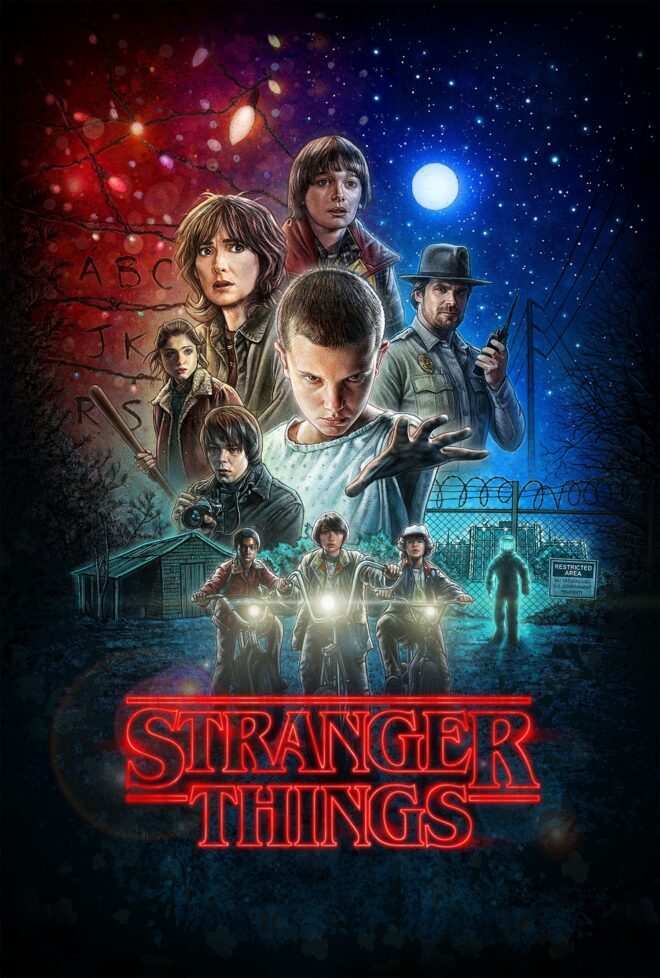November 23, 2020

I’ve recently been rewatching Stranger Things (I’m currently wrapping up Season 2.) Obviously, the show is quite popular, for a variety of reasons. Personally, I’m a fan of supernaturalhorror, and it pairs well with the cozy nostalgia that seems to be part-and-parcel with the 80’s. Most films/shows of this cross-genre features some nerdy “kids on bikes.” And of course, all these kids play D&D. (Not too far from reality, given the game’s huge popularity in the early 80’s.)
So maybe it’s the cosmic terrors of the Upside Down, or it could be the eerily accurate D&D diagnoses throughout the show, but it’s making me think about roleplaying games. Specifically, the character’s various posses are reminding me of an uncommon way to game– troupe-style play.
For those unfamiliar, troupe-style play is when players have a “stable” of available characters to play. Compare that to a standard RPG, where a player uses a single PC for their in-game actions. Some troupes will even have the entire stable be up for play, with any player able to play any PC. Others will have players hop between PCs in a single session, playing each character simultaneously.
(All this lets the players experience a much wider depth of interaction with the game world. Not to mention the roleplaying opportunities between players, letting characters develop different relationships with each other. Ever had to come up with a half-assed reason why the same 5 PCs got together and don’t seem to have any other friends? That problem doesn’t exist when your group collectively runs 15 people.)
See below for ideas on how to use troupe play to run mysteries like the ones in Stranger Things.
Warning: Stranger Things spoilers ahead!
Much of Stranger Things splits characters into distinct groups. These groups often have overlapping goals, but largely work to accomplish them separately from the others. Think of Hopper and Joyce searching the Upside Down for Will, while the kids are fighting the Demogorgon. Right before this, the teens were also fighting the Demogorgon, and briefly interacted with the Joyce/Hopper group across dimensions.
What the show does here is jump from climax to climax, giving the viewers multiple paths to piece together the mysteries of the Upside Down. But it also keeps us guessing, never giving us an exact answer to the question we were looking for.
Something the show does particularly well is firewall the viewer’s knowledge. We often don’t get an “A-Ha!” moment from Group A until Group B has just fallen straight into deep shit. We feel as clueless and in-the-moment as the characters do, totally blind with only a loose plan of action to follow.
And I think this is the groundwork for some really interesting play. I could easily see this mystery-driven campaign explode across the table. 2-4 Players run several different groups, each with a character per group. With multiple intertwined mysteries pulling the groups in different directions, players can choose which group they want to follow, and therefore what scenarios they want to engage with. These groups can then be picked up and played with, working with various investigative procedures to tackle questions.
- The kids have access to Eleven, and a surprisingly accurate D&D Monster Manual to guide them.
- The teens have the freedom to act a bit brazenly. They can get weapons (like the bear trap), sneak around, and generally cause less commotion than the kids since they’re “crazy teenagers.”
- The adults, on the other hand, have access to information. They’re able to move across town freely and have a lot more cred than the other groups. Plus, with Hopper’s position as police chief, he has access to records and methods that no other character offers.
The groups each tackle a certain problem, using their unique abilities to gain further info on topics. As the players start to pull on the strings, it triggers other factors into play, drawing the focus back onto other groups.
For instance, when the kids come across “Will’s body” at the quarry in Season 1, a fantastic switch would be to immediately cut to the Hopper/Joyce group, as they work to identify the body. Hopper has access to the morgue and police, while Joyce has to identify her son.
The kids have essentially activated the “Will’s Body” mystery into play, allowing other groups to interact with it. All the GM needs to do to manage groups is keep a list of the revelations needed to trigger various elements into an active state. Once the conditions are met, simply jolt the players to another group for more dramatic effect. If the group would prefer to take a more calculated approach, I think letting them choose when to switch groups could work just as well.
This kind of dancing back-and-forth between groups can keep the mysteries holding their suspense, letting each group discover different angles. Eventually, the players will gather enough evidence to solve their mystery, making their next moves.
Of course, these mysteries will probably just lead to even bigger questions – who tried to fake Will’s death? And why?
(A: it’s the government. It’s always the government.)
